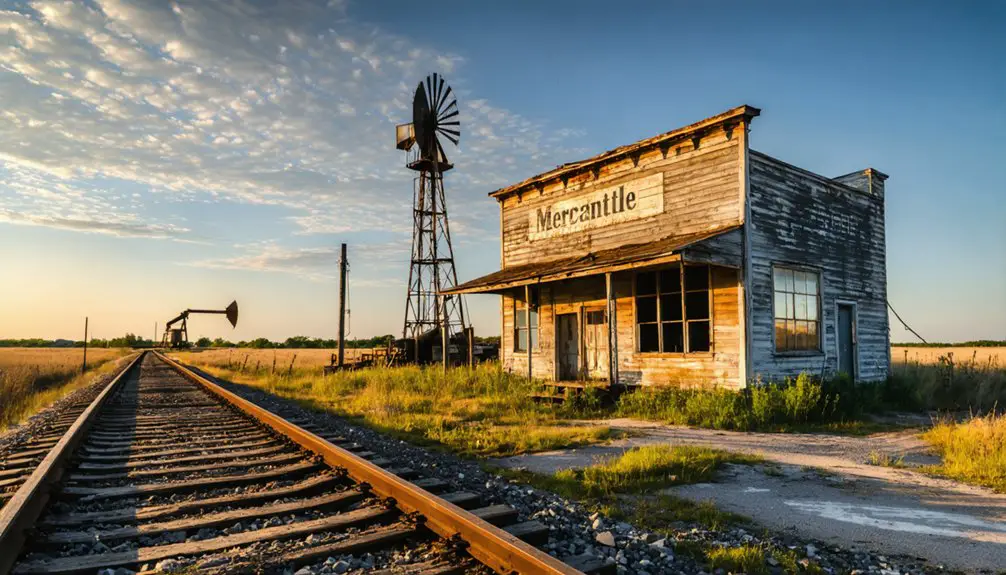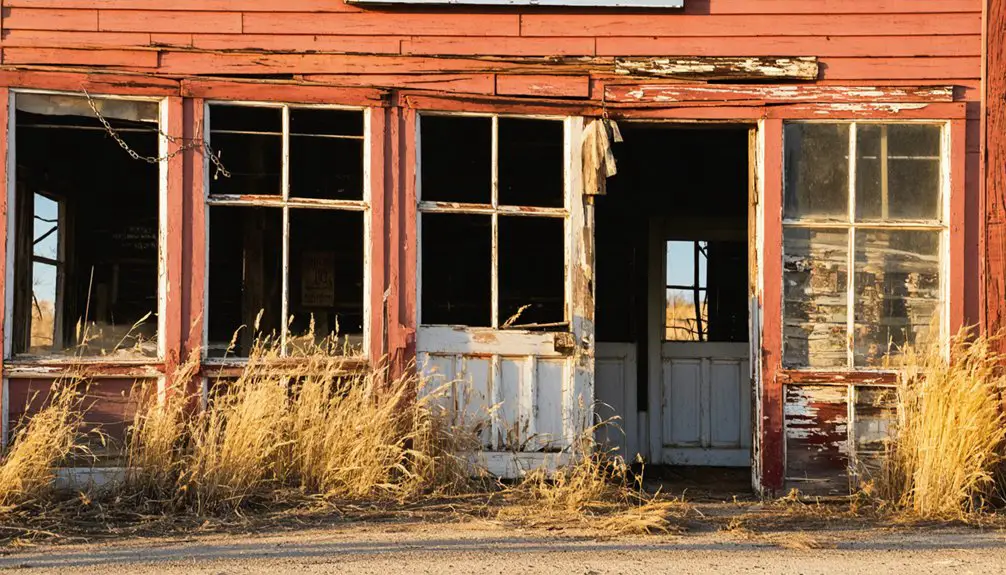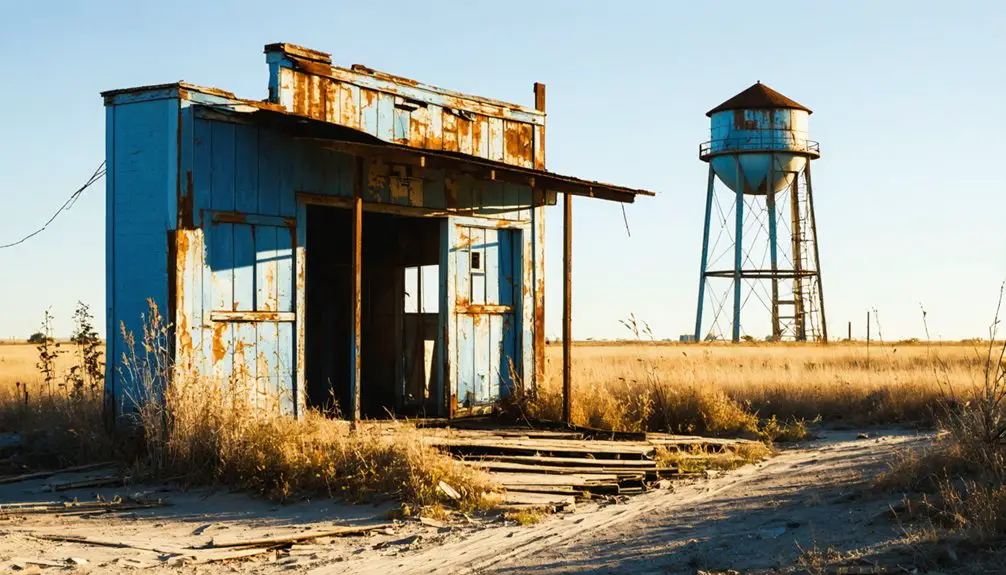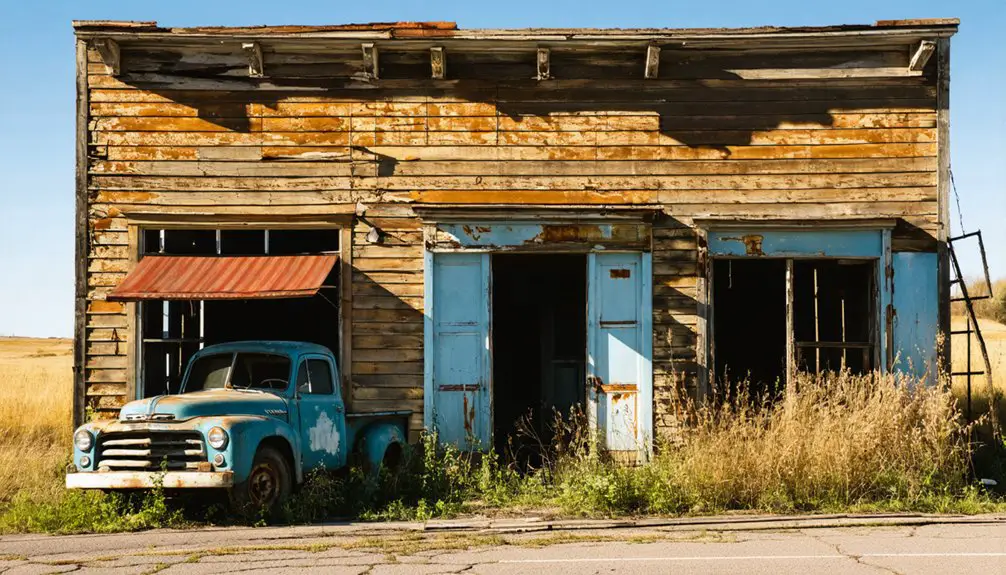You’ll find Glenwood’s remains as a tribute to Oklahoma Territory’s frontier settlement era. Originally known as “Defiance,” this boomtown flourished after the 1889 Land Rush, growing appreciably with the arrival of the Midland Valley Railroad in 1906. By 1920, nearly 900 residents called it home, but the Great Depression, dwindling resources, and the bypass of major transportation routes led to its abandonment. The town’s ruins hold tales of Kid Curry, Doc Holliday, and countless untold frontier stories.
Key Takeaways
- Glenwood transformed from a frontier settlement into a ghost town after railroads declined and the Interstate Highway System bypassed the community.
- The town peaked during 1910-1920 with nearly 900 residents due to railroad development and oil discoveries, but declined sharply afterward.
- Transportation isolation, over-dependence on agriculture, and dwindling natural resources led to Glenwood’s eventual abandonment.
- Local legends of Kid Curry Logan and Doc Holliday contribute to the ghost town’s mystique and reported paranormal activity.
- Originally known as “Defiance,” Glenwood began as a frontier camp of miners, trappers, and traders before establishing formal infrastructure.
The Rise and Fall of a Forgotten Settlement
As Oklahoma Territory opened to settlement in the late 19th century, Glenwood emerged as one of many hopeful frontier communities dotting the changing landscape.
You’ll find its story mirrors the community resilience that marked early territorial development, as settlers established essential services and built connections through local trade.
Like many frontier towns, Glenwood’s fortunes rose with its strategic location near transportation routes, serving farmers and ranchers who faced persistent agricultural challenges. The town’s success paralleled early mining settlements like Acme Cement, which thrived through industrial operations.
Frontier settlements like Glenwood thrived by positioning themselves as vital waypoints for struggling agricultural communities seeking market access.
The town flourished briefly when local commerce, schools, and postal services created a hub of rural activity. As with many Oklahoma settlements of the era, liquor sales boosted the local economy by serving residents from neighboring dry territories.
But time wasn’t kind to Glenwood – economic downturns, shifting transportation patterns, and the consolidation of farming operations gradually drained its lifeblood.
As essential services shuttered and residents sought opportunities elsewhere, Glenwood joined the ranks of Oklahoma’s ghost towns, leaving only weathered remnants of its frontier aspirations.
Historical Significance in Oklahoma Territory
You’ll find that Glenwood’s early settlement patterns mirrored many Oklahoma Territory ghost towns, where communities emerged rapidly near promising natural resources and transportation routes.
The Midland Valley Railroad played a vital role in 1906 by establishing transportation infrastructure that supported the region’s growth.
The town’s fortunes were inextricably tied to railroad development, as it initially flourished when rail lines provided crucial connections for moving goods and people through the territory.
Like countless other Oklahoma settlements of its era, Glenwood’s historical significance stems from its role in demonstrating how railroad access could make or break a community’s survival during the territory’s formative years.
Similar to the historic Train Depot in Glenwood Springs that welcomed U.S. presidents, the Oklahoma town served as an important transit point for distinguished visitors and locals alike.
Early Settlement Patterns
The Oklahoma District’s dramatic transformation began at high noon on April 22, 1889, when 100,000 settlers rushed to claim their piece of the Unassigned Lands.
You’d have witnessed an incredible mix of settler demographics as farmers, speculators, and entrepreneurs arrived by wagon, horseback, bicycle, and train to stake their claims across 1,920,000 acres of newly opened territory.
African Americans participated as Land Rush settlers, seeking new opportunities and a chance at self-determination in the Oklahoma Territory.
The path to land ownership wasn’t simple, though. The federal government had acquired these lands from Creek and Seminole tribes for just over four million dollars, forever changing the region’s landscape.
Many newly emancipated African Americans viewed the territories as a Promised Land where they could escape the South’s oppression.
Settlers typically claimed 160-acre parcels under the Homestead Act, quickly establishing communities that would become thriving centers of commerce.
Boomtowns like Guthrie and Oklahoma City emerged practically overnight, transforming the untamed prairie into organized settlements.
Railroad Development Impact
While settlers rushed to claim their homesteads during the 1889 Land Run, railroad development would soon reshape Oklahoma Territory’s economic landscape even more dramatically.
You’ll find the territory’s railroad expansion reached its zenith between 1897 and 1907, creating an intricate network that transformed isolated settlements into thriving commercial hubs. Foreign investors from Britain, Germany, and the Netherlands poured capital into major lines like the Frisco and Santa Fe, while ambitious entrepreneurs competed to establish new routes and townships. The Frisco Railway’s acquisition in 1876 helped establish numerous settlements across the region. Similar to Glenwood’s experience, the Gurdon and Fort Smith railroad sparked new community development in 1905.
Yet this rapid growth proved unsustainable – by 1940, you’d have seen 75% of these rail lines abandoned.
The 1907 financial panic and Oklahoma’s constitutional restrictions on railroad acquisitions had already signaled the end of this remarkable era of economic transformation.
Economic Forces Behind Glenwood’s Development

As you explore Glenwood’s early development, you’ll find its initial growth was closely tied to railroad construction in the early 20th century, which provided essential transportation links for agricultural products and settlers.
The post-World War I era brought a period of population in the hundreds as the town peaked in size, similar to nearby Keyes. While nearby oil discoveries temporarily boosted the local economy, Glenwood remained primarily dependent on farming and agricultural trade throughout its active years. The Great Depression caused substantial population loss and business closures, mirroring the economic struggles seen across Oklahoma’s small towns.
The town’s eventual decline mirrored many Oklahoma communities, as changes in transportation infrastructure, particularly the reduced importance of railroads and new highway systems that bypassed smaller towns, gradually eroded its economic foundation.
Early Resource-Based Growth
During Oklahoma’s territorial period, Glenwood emerged as a resource-driven settlement where timber harvesting and mineral extraction formed the backbone of its early economic development.
You’ll find that resource exploitation shaped the town’s initial growth, with the timber industry attracting workers who established the first permanent structures.
Here’s what drove Glenwood’s early expansion:
- Vast forests provided lumber for regional construction and railway ties
- Rich mineral deposits, particularly lead and zinc, sparked mining operations
- Local supply stores and worker housing sprang up around extraction sites
- Transient workers and entrepreneurs flocked to the area, establishing a bustling community
The promise of natural resources transformed Glenwood from untamed wilderness into a thriving settlement, though this prosperity would ultimately prove temporary.
Railroad Impact on Development
The arrival of the Memphis, Dallas, and Gulf Railroad in 1914 marked a defining chapter in Glenwood’s evolution from a resource-based settlement to a major rail junction. This railroad innovation transformed the southern Ouachita Mountains region, positioning Glenwood as an essential logistics hub where commerce and industry converged.
You’ll find that this economic transformation touched every aspect of local life. The town’s incorporation in 1908 preceded a dramatic population surge, reaching 768 by 1910 and nearly 900 by 1920.
Local entrepreneurs quickly capitalized on rail access, establishing lumber mills and diverse businesses near the depot. The railroad’s year-round service freed the lumber industry from seasonal constraints, while connecting Glenwood to broader markets.
This reliable transportation network attracted external investment, spurred labor migration, and established Glenwood as a thriving commercial center.
Population Shifts and Decline
While Glenwood initially flourished through its resource-based economy, significant population shifts began to reshape the town’s destiny by the mid-20th century.
The town’s economic resilience was tested as multiple factors drove population migration away from this once-promising settlement.
Key factors that accelerated Glenwood’s decline:
- Over-dependence on agriculture and natural resources left the town vulnerable when soil productivity diminished and farming practices modernized.
- Lack of economic diversification prevented adaptation when primary industries faltered, unlike neighboring towns that developed varied revenue streams.
- Isolation from major transportation routes, especially new highways, cut off crucial economic opportunities.
- Declining local services and infrastructure made it increasingly difficult for residents to maintain their way of life.
Life in Early Glenwood Community

Life in early Glenwood emerged from humble beginnings as a frontier camp known as “Defiance,” where tents and temporary structures dotted the landscape.
You’d have found a bustling mix of miners, trappers, traders, and gunslingers creating vibrant community dynamics in this rough-and-tumble settlement.
Social interactions centered around the town’s saloons, which served as gathering spots for the diverse frontier population.
Transportation Routes and Their Impact
Transportation arteries shaped Glenwood’s destiny from its earliest days, beginning with the Midland Valley Railroad‘s arrival in 1906.
The transportation evolution you’ll recognize in Glenwood’s story mirrors many Oklahoma boom towns that rose and fell with changing times. You’ll see how economic shifts marked distinct chapters in the town’s history.
Four key transportation changes sealed Glenwood’s fate:
- Railroad construction in 1906 sparked initial growth and oil transport
- Route 66’s arrival in 1926 brought temporary prosperity through tourism
- Interstate Highway System construction bypassed the town, diverting traffic
- Loss of viable transportation routes combined with depleted oil resources
These transportation changes, paired with dwindling natural resources, transformed Glenwood from a bustling community into a ghost town, reflecting the broader pattern of Oklahoma’s abandoned settlements.
Notable Structures and Landmarks

Today’s scattered remnants of Glenwood’s structures tell a compelling story of Oklahoma’s boom-and-bust cycles.
You’ll find architectural remnants of single-family homes with their weathered facades and boarded windows standing as silent witnesses to the town’s former liveliness. The abandoned post office building, once a hub of daily life, now sits empty alongside what used to be the community hall where locals gathered for social events.
As you explore deeper into Glenwood, you’ll discover rusting gas pumps near a crumbling general store, preserving community memories of bustling commerce.
The town’s agricultural heritage lives on through deteriorating grain storage facilities and old barns, while nearby railroad loading areas remind you of Glenwood’s important role in regional transportation networks.
Local Stories and Legends
While many Oklahoma ghost towns harbor tales of tragedy and mystery, Glenwood’s legends particularly stand out due to its connections with infamous Wild West figures.
You’ll find the town’s most compelling stories revolve around Kid Curry Logan and Doc Holliday, whose unmarked graves have sparked decades of local hauntings and ghostly encounters.
- Kid Curry’s self-inflicted gunshot and disputed identification have led to persistent tales of his restless spirit wandering the area.
- Doc Holliday’s tuberculosis-driven final days and unknown burial location fuel stories of paranormal activity.
- Disturbed and unmarked graves throughout Glenwood serve as focal points for supernatural occurrences.
- The town’s boom-and-bust history, tied to liquor trade and railroad developments, has created layers of unresolved mysteries that continue to intrigue freedom-seeking explorers.
What Remains Today

Beyond the ghostly legends, modern-day Glenwood stands as a stark reminder of Oklahoma’s boom-and-bust frontier era.
If you’re planning ghost town exploration here, you’ll find deteriorating architectural remnants scattered across a landscape that nature’s slowly reclaiming. The few remaining structures show the telltale signs of decades of abandonment – collapsed roofs, crumbling walls, and weathered foundations barely visible through the prairie grass.
You won’t find any official markers or preserved historic sites. Instead, you’ll discover a raw, unmanaged landscape where agricultural fields and wild vegetation have overtaken the old town boundaries.
Rusted artifacts and homestead debris occasionally surface among the ruins, but they’re becoming increasingly scarce as time marches on. The site’s untamed character offers a rare glimpse into Oklahoma’s vanishing frontier heritage.
Frequently Asked Questions
Are There Any Remaining Residents Living in Glenwood Today?
Like dust in the wind, current inhabitants are nonexistent in this ghost town. You’ll only find local legends and memories here – no permanent residents call this place home anymore.
What Happened to the Town’s Official Records and Documentation?
You won’t find many surviving records – most were lost when buildings collapsed or burned. Poor historical preservation meant archives scattered or deteriorated, with some possibly transferred to county offices but rarely catalogued.
Can Visitors Legally Explore the Remaining Structures in Glenwood?
You can’t legally explore structures without verifying ownership and obtaining permission first. Current exploration guidelines require checking property rights and respecting legal restrictions to avoid trespassing charges.
Were Any Famous Outlaws or Historical Figures Associated With Glenwood?
You won’t find any documented outlaw history or notable figures tied specifically to Glenwood. While Oklahoma had its share of famous outlaws, they weren’t known to frequent this particular ghost town.
Does the Town Site Have Any Environmental Hazards Visitors Should Know About?
A toxic wasteland awaits you. Don’t explore here – severe environmental concerns include lead-contaminated soil, unstable mine shafts prone to collapse, and poisonous dust from chat piles. The site’s completely off-limits for your safety.
References
- https://en.wikipedia.org/wiki/List_of_ghost_towns_in_Oklahoma
- https://www.youtube.com/watch?v=5d-wHDTIbb0
- https://visitglenwood.com/blog/2019/03/the-history-and-ghost-stories-of-glenwood-springs/
- https://www.okhistory.org/publications/enc/entry?entry=GL008
- https://kids.kiddle.co/List_of_ghost_towns_in_Oklahoma
- https://www.okhistory.org/publications/enc/entry?entry=GH002
- https://visitglenwood.com/blog/2025/03/uncovering-mysteries-of-history-in-glenwood-springs/
- https://www.nps.gov/jeff/planyourvisit/settlement-of-the-southern-plains.htm
- https://nmaahc.si.edu/explore/stories/roots-greenwood
- https://www.justiceforgreenwood.org/black-settlement-in-oklahoma/



